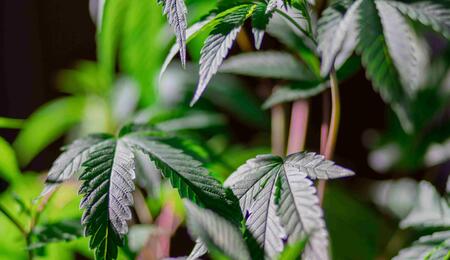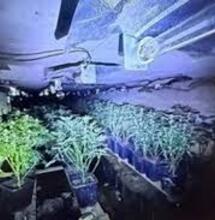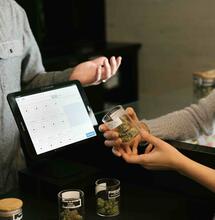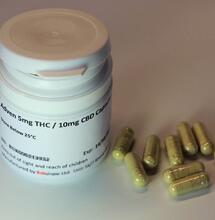Now for something completely different!

Have you been growing for a while? Are you at the stage where no matter which new nutrient, additive or growing method you try, you just can't seem to better your last yield? Think you've got the most out of your growing environment? Maybe it's time to try something completely different.
Have you been growing for a while? Are you at the stage where no matter which new nutrient, additive or growing method you try, you just can't seem to better your last yield? Think you've got the most out of your growing environment? Maybe it's time to try something completely different.
Have you been growing for a while? Are you at the stage where no matter which new nutrient, additive or growing method you try, you just can't seem to better your last yield? Think you've got the most out of your growing environment? Maybe it's time to try something completely different.
| Exploit plant stress to increase flowering sites |
In this instalment of Grow with Little Lebowski, we look at a few techniques for the advanced gardener. By ‘advanced gardener' I don't just necessarily mean those of you that have grown for years, tried different methods of cultivation from hand watering to hydro and can consistently get good yields from your environment. I'm talking about those of you that have got your grow room dialled and are willing to try something a little bit new, those of you that are willing to take a risk or two in pursuit of the highest possible yield and, most importantly, because you are curious to see what will happen if you push your plants (and yourself).
So, all the growers out there that are reliant on the grow room to pay your bills may want to look away now (or just read on and get a mate to try these techniques out), only the risk takers and thrill seekers out there - with a spare lamp just crying out to be used - need apply.
For those of you that are still with me, keep an open mind. We'll start with a simple (as in relatively easy to understand and achieve) concepts and work our way up to the more challenging stuff. Fire up a fun stick (something clear and uplifting) and read on...
Play at nature!
In an indoor garden, you control and manipulate every element that your plants need to develop - if ever there was an ideal hobby for someone with a god complex, its home growing! - and this level of control can, in theory, extend to taking charge of the seasons. To an extent, if you are growing now, you are already doing it. Think about it, when you switch your lighting to 12/12 you force your plants to flower by reducing the amount of ‘daylight' hours they receive, fooling them into thinking the colder weather is on the way and it is time for them to reproduce.
What happens when you take this one step further? What happens if you do bring on the ‘cold weather'? There are two possibilities here, one relates to increasing the yield and the other relates to bringing the crop to an early finish, without reducing quality.
Night time temperatures - the difference between day time and night time temperatures is referred to as the DIF and it is widely agreed that increasing the DIF has a positive effect in steering most plants towards flowering. When growing indoors it is pretty straightforward to record day and night temperatures using a simple max / min thermometer. It is also straightforward to drop the night temperature, because the biggest source of heat - the lamp - is off during the night period.
During the veg stage, you will achieve optimum growth by keeping the DIF constant, use a fan heater, or similar, to raise the night temperature once the lamp is off. Measure your min night temperatures and set the heater on a timer to warm the grow room throughout the lights off period.
For the flowering stage, the optimum DIF is around 8ºc to 10ºc, so if your maximum day temp is around 28º c, aim for a night temperature of around 18ºc.
This drop in temperature forces sugars held in the plant towards the buds. This is because as the air temperature cools, the plant will cool with it, the leaves hold less mass than the buds and so cool at a quicker pace causing the sugars held in them - that they have been producing all day - to be moved to the flowering sites, where they advance bud growth.
Bring on the autumn - otherwise known as Vernalisation, this technique can be utilised to deliberately finish a crop early without compromising too much on the quality of the end product. Certain plant species actually require a period of cold temperatures to induce flowering, for example strawberries in the garden will only start to produce fruit after the cold ‘snap' in winter. However, for the majority of plants - the good lady, Cannabis, included - cold periods will cause pigments (green coloured chlorophyll) in the leaves to retract, this is why certain strains of Cannabis will turn purple or blue if grown in colder conditions.
During the flowering period, buds require more and more sugars to develop properly and reach full potential. These are created via the pigments in the leaves trapping light and converting it to sugar (photosynthesis). If the temperature in the environment is deliberately lowered, the pigments retract and the plants metabolism will begin to shut down. You will literally be simulating nature - the onset of the cold weather - this will trigger a release of hormones within the plant, which will ‘finish' the crop early and the plant will then begin to die back.
Obviously yield will be compromised, but the actual quality of the end product will be far superior to just chopping the plant early. A helpful technique for commercial situations.
Stress to impress!
This is perhaps the most challenging concept of all and one that is only recommended for those willing to take a risk, throw caution to the wind and try something completely different.
Over and under feeding, too much heat or humidity, pest attack, cold roots; a stressed plant is an unhappy plant, right? To an extent, yes; but there is a school of thought out there that believe that some stress can be good for the plant and can be utilised by the grower to steer the plant in the right direction.
| Increase the DIF. Lower night temperatures can stimulate production |
Most growers will already be deliberately stressing their plants to their own advantage. Don't believe me? How many of you employ the following tactics...?
Topping and Fimming - a very common stress technique used to force the plant to bush out and grow laterally, developing additional flowering sites as it does so. Topping simply involves removing the growing tip of the plant to make it more productive, i.e. rather than developing just one main cola, more side shoots develop and more bud sites are formed.
Thinning - this technique involves removing branches and leaves that are superfluous to requirements. Usually leafy foliage that sits under the main canopy is removed, as it no longer receives much light and is therefore unproductive. By removing this foliage during the start of the flowering period, energy is diverted to bud production and, while this undoubtedly stresses the plant, it will result in faster bud development and - ultimately - improved yields.
Root pruning - any grower who has ever vegged using rock wool cubes on a ridged tray or grown their plants in an air pot or fabric pot, has utilised the root pruning technique. This involves allowing the very tip of the root to come into contact with the air, which dries it out until it eventually dies back. This stressful occurrence forces the root to put out a secondary root branch, which in turn is pruned by the air and puts out its own secondary root. Root pruning causes the plant to develop an increased root mass, which - in turn - means an increased level of nutrient uptake and faster growth.
| Root pruning pots involve a commonly used stress technique - air pruning |
These deliberate stress inducement techniques are helpful tools for every grower and it's pretty clear how they affect growth rates and yield. But what about inflicting deliberate harm on the plant? This is where things get a bit risky.
From my own experience, I can recall an example where stressing plants through drought appeared to spurn on a spell of rapid growth:
Once, when bringing on eight clones in an aeroponic propagator, I accidentally (and soberly, which is even more embarrassing!) turned off the pump that was running the sprinklers and left the grow room for the day. When I returned, the clones - which had only gone into the prop the day before - had wilted to the extent that they were now laid flat on the tray of the propagator! Thinking there was nothing to lose; I turned the pump back on and kept my fingers crossed. Within three hours they were upright, within four days they had rooted out and then went on to become some of the strongest and biggest yielding plants that I have grown.
Could it be that a dose of stress in their early stages boosted them to become stronger later in their development? Maybe.
A mate of mine had a similar experience when he was unexpectedly kept away from home over a weekend. When he returned his four young seedlings - at that point in 3" soil pots - were wilted and the edge of the leaves had started to crisp. Eleven weeks later, he set his grow room record yield with them and says, to this day, that they were the most ferocious growers he has ever encountered.
Now, I'm not recommending that you bring your plants close to death then try and bring them back from the brink, far from it. But there are a couple of techniques that are fairly well documented in steering plants towards the flowering - or generative - phase. Note that during the vegetative phase the way to attain the best results - i.e. keep the veg period as productive and short as possible - is to water frequently at a low EC, ensure the root zone doesn't dry out and keep day and night temperatures as constant as possible (as stated earlier, this is commonly known as the DIF).
For those brave enough to embark on something new - and already have 100% confidence that all of your environmental factors are correct - give these a try once you have switched to 12 / 12...
Raise the nutrient strength - this is best experimented on a strain that you have grown before and which you are familiar with the tolerance to nutrients. When entering the flowering period, raise the level of feed to just under the upper tolerance of the strain. The higher concentration of nutrient around the roots, restricts the uptake of water and stresses the plant; steering it towards flowering. Note: this technique is more straightforward in recirculating hydro than soil or coco, as you can measure nutrient uptake and strength easily, using an EC meter.
Dry out the root zone - despite my earlier anecdote, we are not talking about letting your plants completely dry out to the extent that they wilt. Instead, reduce the frequency of feeding so that the roots begin to dehydrate slightly; this will stress the plant, encouraging earlier flower development. There is no need to change the actual volume of nutrient solution that you feed the plant, just alter the times that you feed - increase the duration between feed periods by 10% - 20% this allows the media to dry without causing irreversible damage to the roots themselves. Note: this technique should only be attempted when using a growing method where the roots are surrounded by a growing medium. It should not be utilised in ‘bare rooted' hydro techniques such as NFT and aeroponics where turning off the supply of nutrient solution to the roots can quickly cause damage. The technique is, however, well suited to drip irrigation where it is easy to control the number and duration of feeds per day.
| Worth the risk? Definitely! |
For example, if growing using drippers and clay pebbles and feeding six times a day for 10 minutes, adjust the irrigation to three times a day for 20 minutes. Same volume of feed, but the longer duration between each irrigation period will dry out the root zone and stress the plant.
Not only should these techniques force your plants into earlier flowering, but the application of this stress should also divert energy into bud production, resulting in a higher overall yield.
Good luck... and don't say I didn't warn you!



